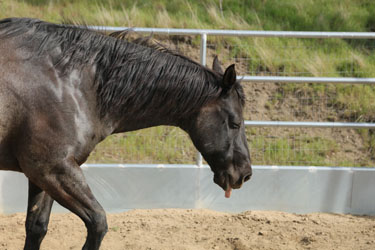Veterinarian Tips: Equine Anhidrosis

It’s easy to tell when a horse has been exercised on a warm and humid day. Sweat droplets roll down and drip off from under the belly, and there may be a foamy lather on the sides of the animal’s neck and in between its hind legs. While it may look like the animal was overworked, this is actually just a typical sign of sweating.
While sweating naturally helps a horse to regulate its body temperature, some suffer from anhidrosis, a medical condition that interferes with the animal’s ability to sweat. Most often observed in performance and racehorses, anhidrosis mostly affects animals living in climates that are hot and humid, such as in the areas of Florida and along the Gulf Coast.
This problem is most often observed during hot weather. Here’s what to tell your equine clients about anhidrosis:
Cause of Equine Anhidrosis
While most horses sweat when they experience an increase in body temperature, an anhidrotic horse doesn’t. Anhidrosis does not affect all animals to the same degree; for instance, some may:
- Completely stop sweating
- Sweat, but in a decreased amount
- Have only certain areas that don’t sweat.
While the cause of anhidrosis is not completely understood, it is thought to be connected to the way that epinephrine receptors respond to the effects of epinephrine. It is also felt that the condition is further aggravated because the animal’s hair follicles eventually become plugged with dried sebum.
Signs of Anhidrosis
The onset of anhidrosis can be sudden or gradual. Sudden onset usually occurs when the animal has been exercised in hot weather. If the veterinarian is not made aware of the animal’s lack of sweating, the horse may be misdiagnosed as having a respiratory infection. Along with a lack of sweating, signs of anhidrosis include:
- Increased heart rate
- High fever
- Dry skin
- Rapid, labored breathing with flared nostrils at rest
- Panting
- Fatigue
- Collapse
- Dehydration, leading to heat stroke.
In animals with gradual onset, the signs may include the following:
- Weight loss
- Increased thirst
- Increased urination
- Lack of appetite
- Loss of body condition
- Intolerance to exercise
- Changes to hair and coat, including:
- Dry, rough coat
- Scaling
- Itching
- Regional balding, patchy hair loss over face.
Diagnosis
Determining if a horse is anhidrotic is done by injecting epinephrine or a dilution of terbutaline into a patch of skin.
- If the animal is not anhidrotic, it will sweat profusely from the area within 30 minutes
- If the animal is anhidrotic, it will either not sweat at all from the patch, or it will only sweat once the dosage has been greatly increased.
Treatment for Equine Anhidrosis
There is no cure for anhidrosis, but electrolyte supplements are often turned to for treatment.
When a horse has been diagnosed with anhidrosis, it is important to help clients understand that they don’t have to move their animal to a cooler climate. The following management suggestions will help to identify how they can best provide for the needs of their animal:
- Offer an environment that is cooler for the horse during warmer weather by providing an area that is, for instance:
- Fan-cooled or air-conditioned
- Shaded
- Supplied with a water mister
- Exercise the animal only minimally in warm weather or only during the cooler early morning/late evening hours
- Turn out to pasture during the evening hours when the temperatures are lower and there is a greater chance of a breeze
- Offer cool, fresh water at all times
- Mist the coat with water and spray the neck, legs, and body to help cool the horse off
- After an exercise period, allow for enough time to let the horse cool down while monitoring its respiration rate
- Clip the hair short during the warmer months
- When grooming, rub vigorously to stimulate the blood flow to the skin.
Without the proper care, an anhidrotic horse could be at risk of developing heat stroke. It is vital that equine clients know to contact their veterinarian at the first sign of a problem.
Your Covetrus representative can provide other tips and suggestions of value to you and your clients! Contact us at: 855.724.3461 or online.


Working Here
Our team members are encouraged to be the best they can be... at Covetrus we believe we impact one another.
Learn MoreNews & Events
FDA Cautions Pet Owners Not to Feed Texas Tripe Inc. Raw Pet Food Due to Salmonella, Listeria Monocytogenes
The U.S. Food and Drug Administration is cautioning pet owners not to feed their pets any of the Texas Tripe brand raw frozen pet food listed below because several samples of Texas Tripe raw pet food have tested positive for Salmonella and/or L. mono.
Careers
Are you looking for a place to let your talents shine? At Covetrus, we help our practitioner customers better serve their patients and take pride in providing the best customer experience possible. Search our open positions to see our available opportunities.
Newsletter
Stay current with what’s going on with Covetrus, subscribe to receive our newsletter and email communications. Subscribers will receive the latest information in practice management, sales and marketing, animal health, and more.



-3-(1).png?sfvrsn=2d806d73_0)

Leave a comment